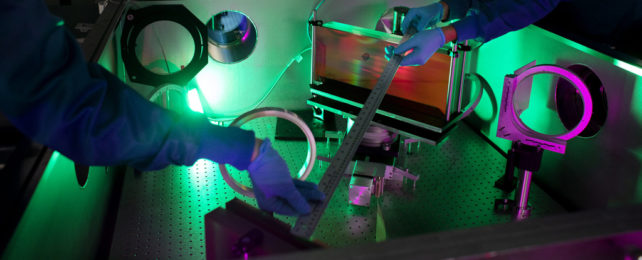The most powerful laser in the US right now is getting turned on to send its first pulses this week – enabling researchers to get a new level of insight into plasma physics and particle accelerators.
Known as the Zetawatt-Equivalent Ultrashort pulse laser System (ZEUS), it produces an ultra-short, extremely powerful pulse of just 25 femtoseconds. A femtosecond is a quadrillionth of a second – or to put it another way, a femtosecond is to a second what a second is to about 31.71 million years.
As the laser's capabilities are ramped up, it could eventually be used to study some of the most exotic phenomena of the Universe at the laboratory scale: think the physics of a gamma-ray burst or a black hole.
"ZEUS will be the highest peak power laser in the US and among the most powerful laser systems in the world," says astrophysicist Karl Krushelnick from the University of Michigan.
ZEUS is going to start on a smaller scale and then build up: the first part of the laser to be turned on is known as the high-repetition target area, which uses pulses of a higher frequency but at a lower power.
This initial stage is going to require 30 terawatts (30 trillion watts) of power – an impressive amount, but only a single percent of what ZEUS will eventually be capable of. The power will be used to study a new kind of X-ray imaging.
By sending infrared laser pulses from ZEUS into helium gas that then turns into plasma, researchers want to create compact X-ray pulses from highly excited electron beams. These X-ray pulses have the potential to be used as a very precise, very accurate method for imaging soft tissue.
By the end of 2023, ZEUS should be running full-scale experiments in fields covering quantum physics, data security, materials science, remote sensing, and medical diagnostics – as well as the study of some of the most extreme objects out there in space.
"Magnetars, which are neutron stars with extremely strong magnetic fields around them, and objects like active galactic nuclei surrounded by very hot plasma – we can recreate the microphysics of hot plasma in extremely strong fields in the laboratory," says electrical and computer engineer Louise Willingale from the University of Michigan.
One area of the laser uses what's known as colliding beam geometry, where the laser pulse is split into two parts: one of the pulses can then be used to accelerate electrons into a high-speed beam that can then be directed to interact back with the second laser pulse.
This leads to a simulation a million times more powerful than the actual capacity of ZEUS can create with just one pulse.
Scientists continue to make substantial progress in making lasers that are more versatile, more stable, and more powerful than ever before – and that means experiments can be carried out on grander and grander scales.
The team behind the development and launch of ZEUS emphasizes that the laser is available for researchers around the world. Scientists interested in using it can submit their proposals for approval.
"We're looking forward to growing the research community and bringing in people with new ideas for experiments and applications," says Krushelnick.
You can read more about ZEUS at its official homepage.
